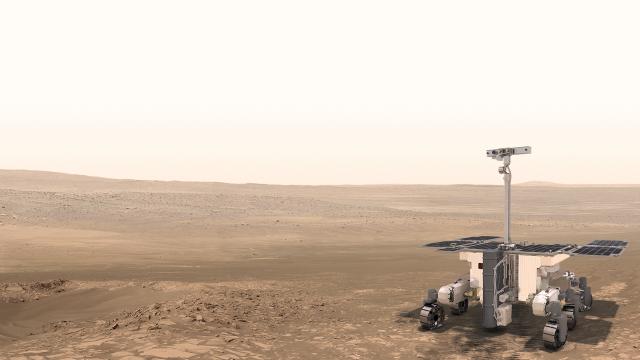Unfinished tests and complications arising from the coronavirus pandemic have forced the European Space Agency and Russia’s Roscosmos to postpone the launch of ExoMars, a collaborative mission to land a rover on the Red Planet and search for signs of life.
Going into this year, it wasn’t clear if ExoMars would be ready for launch later this summer as planned, but ongoing technical delays—and now the COVID-19 pandemic—have sealed the deal. There will be no launch in 2020, as the ESA-Roscosmos ExoMars mission has been postponed to 2022, according to an ESA press release.
Owing to the variability of orbital positions involving Earth and Mars, the ideal launch opportunity for Mars-bound spacecraft, known as the Hohmann transfer window, happens only once every 26 months. Accordingly, the launch in 2022 should happen at some point between August and October. The two-year delay sucks, but it could be worse.
Prior to today’s announcement, mission planners were feverishly scrambling to fix the spacecraft’s problematic parachutes, among other outstanding issues. Though I probably shouldn’t use the word “feverishly” so flippantly, given how the coronavirus pandemic made an already bad situation even worse. As noted in the ESA press release, it became difficult to coordinate team members due to the current “epidemiological situation” in Europe—an almost humorously obtuse way to describe the current COVID-19 pandemic.
In the press release, Dmitry Rogozin, the director general of Roscosmos, had this to say about the decision to postpone the mission:
We have made a difficult but well-weighed decision to postpone the launch to 2022. It is driven primarily by the need to maximise the robustness of all ExoMars systems as well as force majeure circumstances related to exacerbation of the epidemiological situation in Europe which left our experts practically no possibility to proceed with travels to partner industries. I am confident that the steps that we and our European colleagues are taking to ensure mission success will be justified and will unquestionably bring solely positive results for the mission implementation.
To which ESA Director General Jan Wörner added:
We want to make ourselves 100% sure of a successful mission. We cannot allow ourselves any margin of error. More verification activities will ensure a safe trip and the best scientific results on Mars.
At a press conference held earlier today, Wörner elaborated, saying they could launch, “but that would mean we are not doing all the tests [and we] cannot really cut corners,” as reported in the New York Times.
In a tweet, Wörner said the postponement shouldn’t affect other missions, namely the pending Martian sample return mission, in which the ESA is collaborating with NASA.
Our teams are continuing to stay on schedule and budget for Mars Sample Return mission. This joint endeavour will allow us to bring samples collected by @NASA‘s rover on Mars back to Earth for study. There is no indication that the ExoMars decision today will impact MSR. https://t.co/uURp2nKA67
— Jan Wörner (@janwoerner) March 12, 2020
This is all such a shame because, aside from some final tests and adjustments, the ExoMars mission appeared to be ready to go.
All the flight hardware required for launch was installed onto the spacecraft, while the system’s landing platform, called Kazachok, was also ready to go, with its scientific instruments tested, working, and accounted for, according to the ESA. The Rosalind Franklin rover was also ready for launch atop a Russian Proton rocket, having recently completed thermal and vacuum tests. Once on Mars, this rover will search for signs of life, digging to a depth of two metres.
That said, pressing questions remained about the system’s two parachutes, which will slow the lander during its descent to the Martian surface. Parachute deployment tests done last year in May and August both failed, placing the mission in jeopardy.
Tests done in late 2019 resulted in progress, but a pair of final high-altitude tests for both parachutes had yet to happen. These tests were scheduled to take place in Oregon later this month, which, if successful, would’ve met the April deadline to meet the 2020 launch window. If there’s any silver lining to the postponement, it’s that the parachute component no longer needs to be rushed.
The ESA also reports that the system’s descent module was still going through tests related to its propulsion system, and the New York Times says engineers are trying to fix issues with its electronics. Both the descent module and the Kazachok lander have yet to complete environmental testing to ensure their components are fit for the journey to the Red Planet, according to the ESA.
The ExoMars mission might or might not have been ready for the 2020 launch window, but now we’ll never know.
There are other scheduled launches to think about for the coming year, namely NASA’s Mars 2020 Perseverance rover, the United Arab Emirates’s Hope Mars Mission, and China’s Chang’e 5 lunar sample return mission. These missions—as far as we know—are still going to happen. But with covid-19, things are changing by the minute, so we should take nothing for granted.
This latest postponement is yet another frustrating setback for ExoMars. As you may recall, the previous ExoMars mission in 2016 resulted in the loss of the Schiaparelli lander, which crashed onto the Martian surface due to an apparent computer glitch.
